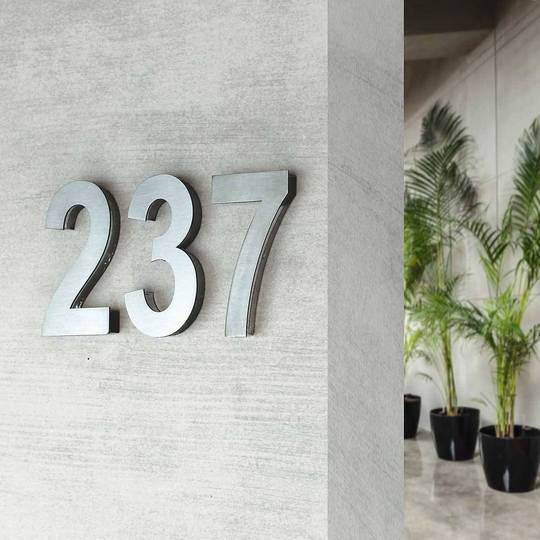
ADA signs in hotels: What should I consider?
In order for the hotel to be a real center of hospitality, all the details in it should be aimed at ensuring the comfort of guests. Among others, for those who have special needs.
Interior signs and numbers that meet ADA requirements, help to organize a real inclusive space that is convenient for everyone. Next, we will tell you what Braille is and what are the requirements for hotel room signs that you need to know when ordering such products.
Why is it important to comply with ADA requirements?
Laws in the US explicitly state that all places where people live (such as hotels, motels, etc.) must comply with the ADA. Otherwise, you will have to pay fines. Or also respond to lawsuits if the lack of the necessary signs led, for example, to injury of the guest.
But many of the hotel owners, using the same Braille, are still primarily guided by humanity. And takes care that the guests:
- are as satisfied as possible with the service;
- felt safe;
- have no restrictions related to physical disabilities (for example, vision, hearing, or musculoskeletal system).
Those who work in the hospitality industry are well aware that satisfied guests not only return themselves, but also advise the hotel to others, in person or in reviews on the internet.
So, ADA interior signs supplemented with Braille, help hotels build a reputation. A good reputation is the key to popularity among customers and the availability of profit.

List of places to place ADA signs in hotels
Of course, in many ways the location of the signs with Braille depends on the layout of a particular hotel. But the list below will help you navigate where these products are needed first.
- Parking. You should indicate which places are provided for people with special needs. It is also important to place signs that will help you understand the direction of movement to the parking lot in the building.
- Sidewalks and paths. So that a person who, for example, moves in a wheelchair or with a walker, could feel comfortable, it would not hurt to place signs indicating where the ramp is. You can also mark where the stairs are located. And it is even better to warn with the same signs if somewhere on the track there is a height difference of more than 1/4 inch.
- Doors. It may happen that not all doors of a building are convenient for those who move around, for example, on crutches. Therefore, it is better to add signs that will help the person get to the door they need.
Important! The sign should not be placed on the doors, but next to them, on the side of the handle. This is especially important for signs with Braille.
- Reception. Usually in hotels, guests fill out registration forms. To keep guests with special needs comfortable, folding boards or shelves that are 36 inches high are often used. It will be useful to place a sign indicating the presence of such a board.
- Rescue zones. They should be marked in those hotels that are not equipped with a sprinkler fire protection system.
- Latrines. You should indicate which one is suitable, for example, for people in wheelchairs.
- Additional amenities for guests. If the hotel has a swimming pool, restaurant, recreation area, library, etc., then you need to have signs that will help people with disabilities get there.

Requirements to ADA signs in hotels or Braille signs in hotels: what to consider
The first thing to take care of is material from which the signs will be made. It should be matte, that is, not give glare, even when it gets bright light.
This greatly simplifies the perception of information for people with visual impairments. Otherwise, they simply won't be able to make out what's written on the sign if it glitters.
Sign can be made from the following materials:
- wood;
- steel;
- matte plastic and acrylic glass.
You also need to add tactile Braille to the signs (it is also called font for the blind). It will allow people to perceive information by touch.
Important! You need to understand that Braille signs people read with their fingertips. Therefore, don't make Braille letters and numbers big. This only complicates the perception.
Base diameter of a dot on signs with Braille — 0.5 inches, and its height — 0.2 inches.
By the way, if your hotel has separate apartments, then their rooms will also have to be duplicated in Braille.

Another important component — contrast ratio. So that the information can be quickly understood, you should not use similar colors on the sign, such as a black background and brown letters. With this design, the text is difficult to read even for a person who sees well.
It is better to give preference to light symbols on a dark background and vice versa. You can also use the 70/30 rule. In other words, the colors on the sign are distributed in this ratio, for example: 70% of the yellow background and 30% of the black text.
By following these rules, you can significantly facilitate the life of guests.
To make the text of hotel signs easy to read, you should also remember the following tips:
- you should not use different fonts on the same sign;
- keep the distance between letters and words, don't put them too close together;
- the text is easy to read when the distance between lines is 30% greater than the height of the letters;
- avoid letters, that are too twisted;
- do not make the lines too short, because the constant translation of the gaze is tedious and does not allow you to easily perceive the text.
Also, you can place pictograms on information signs for hotels or instead of them. For example, the toilet sign (WC) which is known to most people, as well as the fire extinguisher sign. The absolute advantage of pictograms is that they are clear to everyone, and you don't need to know the language for this. They are also visible from afar.

As for placement height, it ranges from 47 to 63 inches from floor level. Remember that Braille is used also by people in wheelchairs. Therefore, they should be able to easily touch the sign.
If you need tactile signs in Braille for hotels, we are ready to create them for you. Fill in the form and very soon Bsign manager will contact you. He will provide a free consultation on ADA signposts during which you can discuss your design suggestions and other important details, such as the possibility of customization of hotel door signs in Braille.
































